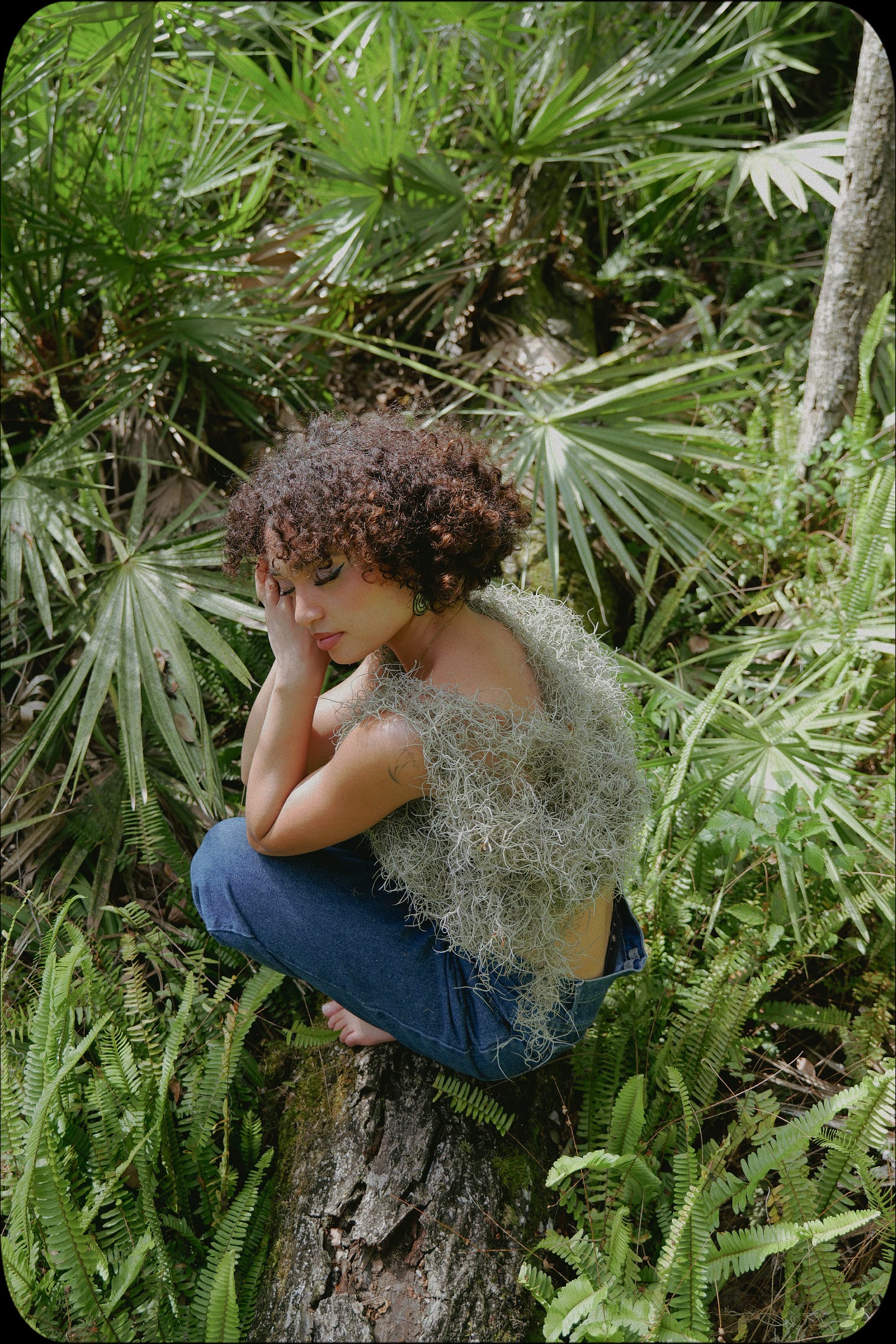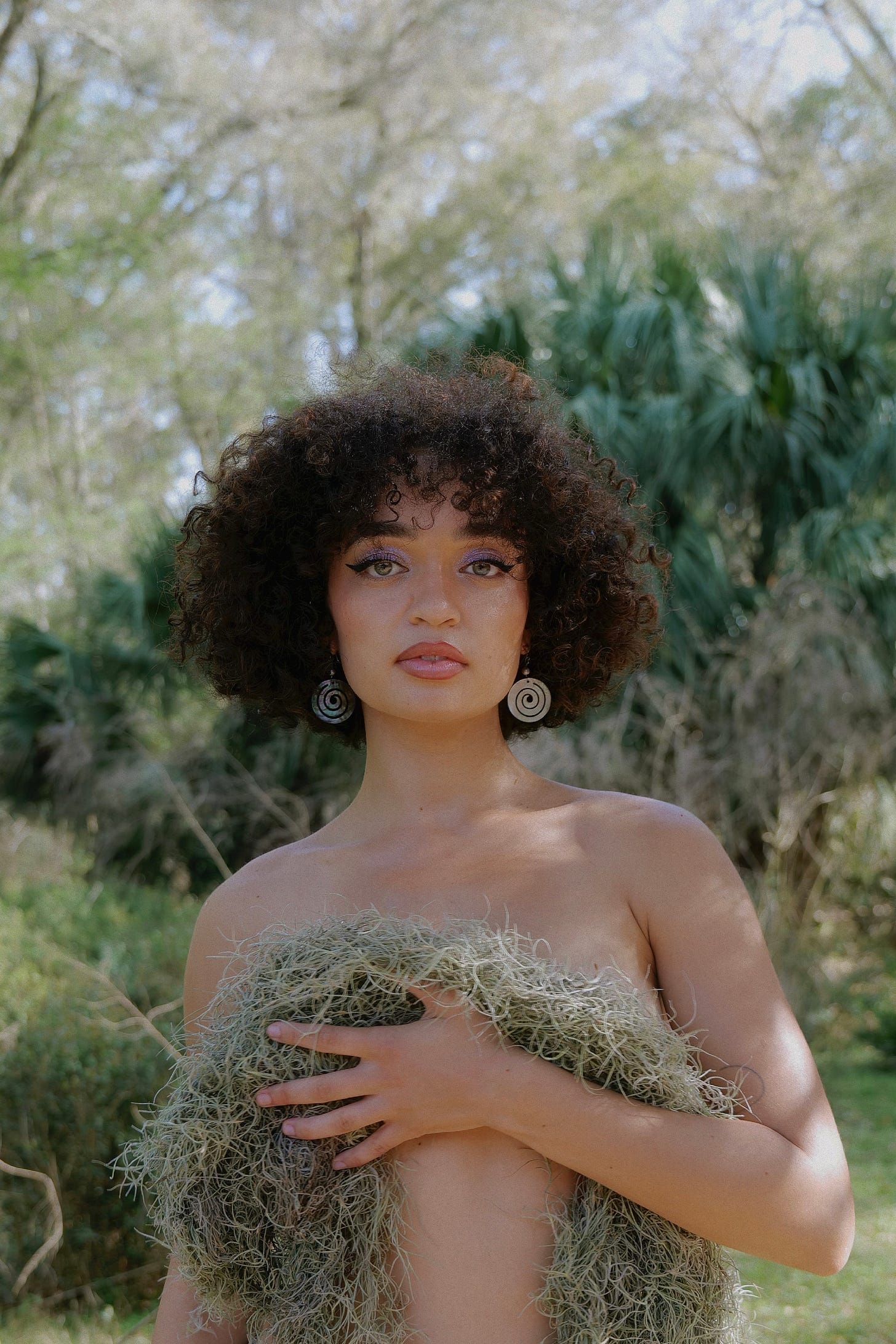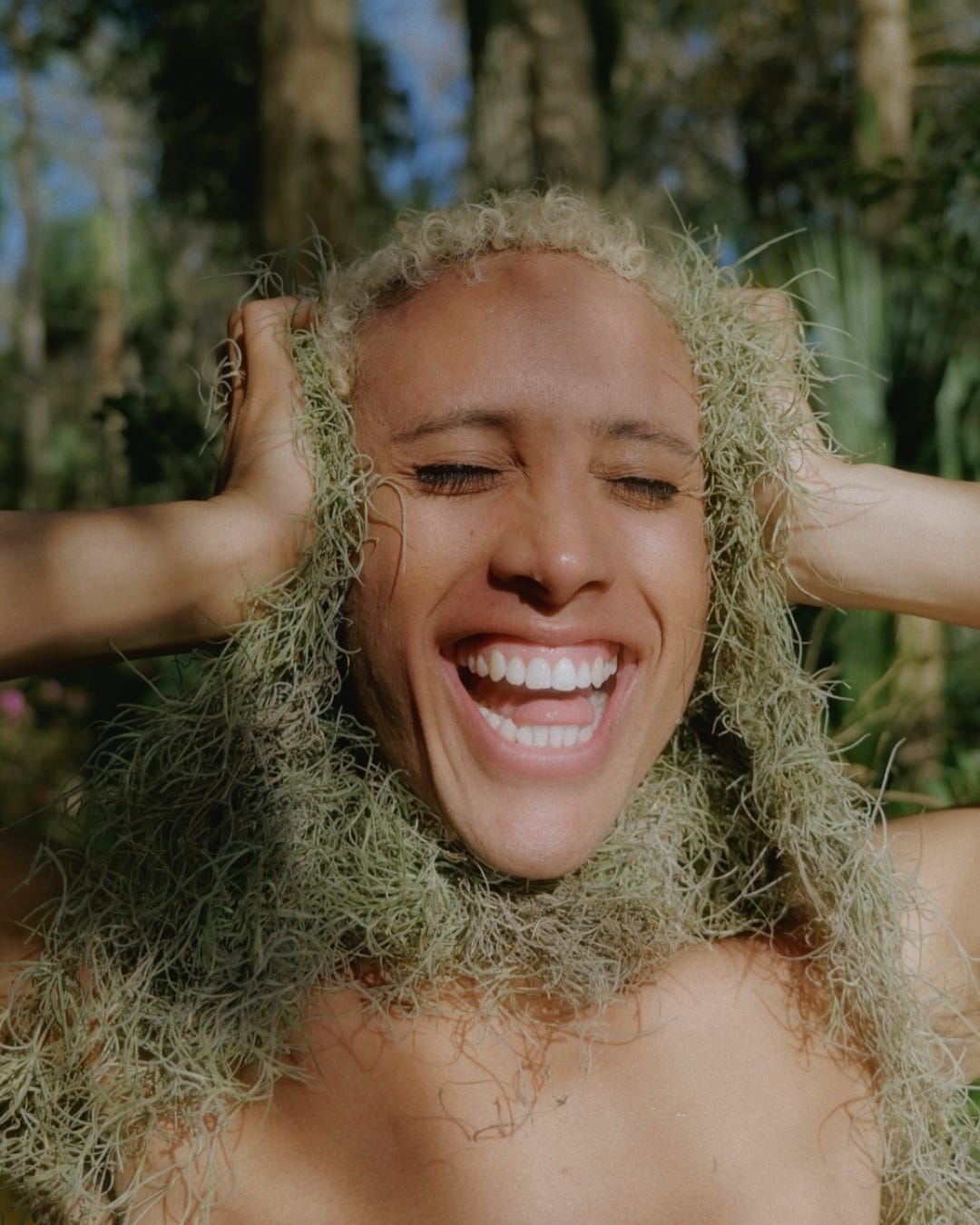Spanish Moss & The Spirit of Survival
Healing, Memory, and the Sacredness of Black and Indigenous Connection to the Land
If you’ve ever been to the Southern United States, you’ve likely encountered its distinctive ecosystems: abundant swamps, dense pine forests alive with the hum of cicadas, and groves of towering oak trees. The long, outstretched branches of these oaks are often draped with one of the most ethereal plants of all—Spanish moss—which I like to call the tresses of Mother Earth. It's rare to find an oak tree in the South whose branches aren’t adorned with this soft, pale green, whimsical-looking air plant.
Despite its name, Spanish moss (Tillandsia usneoides) is neither Spanish nor moss. It’s an epiphyte, meaning it doesn’t root in soil; instead, it absorbs nutrients and moisture through its leaves from the air and rain. Surprisingly, it’s more closely related to the pineapple than to any moss or lichen. And its connection to Black Americans and Indigenous peoples runs deep—spiritual, historical, and profoundly personal. The origin story of Spanish moss is rooted in Indigenous folklore, infused with themes of colonization, spirituality, and love.
In Indigenous American cultures, plants are more than medicine—they are storytellers. They are alive with spirit and wisdom, guiding us through history, connecting us to the divine, teaching lessons, and helping us heal. Indigenous communities have long seen plants as intelligent, sovereign beings—a belief modern science is only now beginning to appreciate.
The spiritual wisdom of plants on Turtle Island (North America) and their relationship with humans has been beautifully documented in books like Braiding Sweetgrass, Fresh Banana Leaves, The Serviceberry, and others. As a biracial Black woman, stories like these have inspired me to learn more about my own ancestors’ relationship with the natural world—how they turned to Mother Earth for strength, healing, and survival through unimaginable oppression.
In late February of this year, I returned to the Florida Panhandle, a place I briefly lived as a teenager after my parents relocated for work. I hadn’t been back in nearly a decade, and this trip felt like a homecoming to a past life. But this time, I returned with my best friend, Laiyonelth—an Afro-Colombian artist, activist, and storyteller. Coming back to the South after so many years was deeply emotional. Florida was where I first felt the effects of the BP oil spill, and it’s also where I discovered my passion for healing our relationship with the earth. It’s where I found my voice and stepped out of my shy comfort zone.
After landing in Panama City, the town I once called home, I felt a surge of emotion seeing the emerald-green waters of the Gulf of Mexico and driving through thick pine forests toward my old neighborhood. As we neared it, I noticed the sway of Spanish moss hanging from the oak branches in the breeze, as if offering a gentle wave to welcome me home. There was something different about its presence this time. You won’t find Spanish moss anywhere else in the U.S. quite like in the South—and after a decade away, it felt like a tender greeting from an old relative.
There’s something meditative about watching Spanish moss drift in the breeze. When the wind touches her, it feels like she lets out a soft sigh of relief. Her sage-green strands shimmer in the light like flowing water, and time seems to stop. The dimensions of reality fold, and I feel as though I’ve stepped back 200 years, watching the same moss sway in the breeze. When I see Spanish moss, I think of my ancestors. The veil thins, and I feel their presence with me.
My dad’s side of the family is from South Texas, where the racial history of the U.S. feels especially personal. My great-grandfather, Alex Dean, grew up picking cotton for wealthy white people, and just a few generations earlier, my family were among the last enslaved Black people in the U.S. Although the importation of slaves was banned in 1808, Abraham Lincoln didn’t sign the Emancipation Proclamation until 1863. Even then, enforcement was slow. It wasn’t until June 19, 1865, more than 900 days later— that Union troops arrived in Galveston, Texas, to inform the enslaved that they were free. My ancestors were among the 250,000 enslaved Black people in Texas who finally received word of their freedom on that day, now commemorated as Juneteenth.
Oak trees can live for hundreds, even thousands, of years. That means the same oaks and Spanish mosses we see today bore witness to the horrific tragedies of the transatlantic slave trade. So when I look at Spanish moss, I think about what it has seen. I wonder what stories the trees and mosses could tell—of pain, of resilience, of buried histories that linger just beneath the surface of our collective memory.
But the story of Spanish moss isn’t only about trauma. One of the cruelest legacies of white supremacy is how it has erased and minimized Black people's relationship to the land. In the stories we hear about chattel slavery, the focus is often on pain, but rarely do we hear about the deep, reciprocal relationships our ancestors had with the natural world—relationships rooted in healing, joy, and survival. With the support of Indigenous tribes at the time, Spanish moss became a source of comfort and care for enslaved Black people.
Hanging from the oaks, Spanish moss offered a cool, shaded refuge from the relentless Southern heat. As Deborah London described after visiting a plantation in South Carolina:
“The day we visited, it was humid and 92 degrees. Outside the sanctuary of the massive tree line, it was oppressive. But one step into the protection of the Spanish moss and the oppression disappeared. The moss absorbed the humidity and made the summer heat bearable. Slave families would gather under the moss to rest, celebrate their Gullah heritage, hope, dream...and grieve.”
Enslaved women also used Spanish moss medicinally—to ease menstrual pain, pack wounds, and treat a variety of ailments.
With the help of Spanish moss, my ancestors found healing. Under her shade, they sang, mourned, rejoiced, and built community. Unlike those who tried to dehumanize them, they formed deep bonds with the living world around them.
So when I see Spanish moss, I don’t only see the pain. I see resilience. I see the power to create something beautiful out of nothing. I see rest and joy used as tools of liberation. Like Spanish moss who grows with no roots, descendants of enslaved people often lack a clear sense of ancestral roots—many of us don’t know exactly where we come from. We were brought to this land against our will, ripped from our origins. Yet, without roots, we still created culture, community, and new ways of being. Spanish moss, carried by wind or birds for miles, lands where it lands with no roots and makes a home. It contributes to the ecosystem wherever it settles. When I look at her, I feel the stories of survival and transformation radiating from her leaves. I feel connected to her.
During my recent trip to Florida, I felt especially drawn to Spanish moss. As she swayed in the trees, something inside me called to co-create with her. At one park, I noticed a large amount of moss on the ground near the forest’s edge. Laiyonelth and I gathered some and brought them back to our hotel. As a sustainable fashion lover, I immediately envisioned creating something wearable from her soft, beautiful strands.
The day we made the pieces, it felt effortless. I braided the moss into a wrap top with straps, and the strong, sticky leaves held together without any pins. These photos are meant to evoke the joy, rest, healing, and playfulness that Spanish moss brought to our ancestors. They’re a reminder of Black people's long-standing, sacred connection to the earth—and a testament that even in the depths of darkness and the collapse of a system, with joy, rest, imagination, and play, we can build a new world from nothing.
In heavy times like the ones we’re living through now, I remind myself: the systems trying to destroy us now didn’t appear out of nowhere. They’re a continuation of the same oppressive structures that sought to subjugate our ancestors. Any effort to build a better world must learn from those who resisted before us. And when we listen to Mother Nature, she will always be here to guide us back to who we’ve always been.












Excellent article young lady keep up the great work 👊🏽✊🏽💪🏽💪🏽🙏🏽🙏🏽🙏🏽🌍🌍🌍🌲♥️♥️🧚🏼♂️I hope that one day you feel safe enough to let me into your life -peace and blessings to you
So beautifully written and photographed 🥹 love this sm